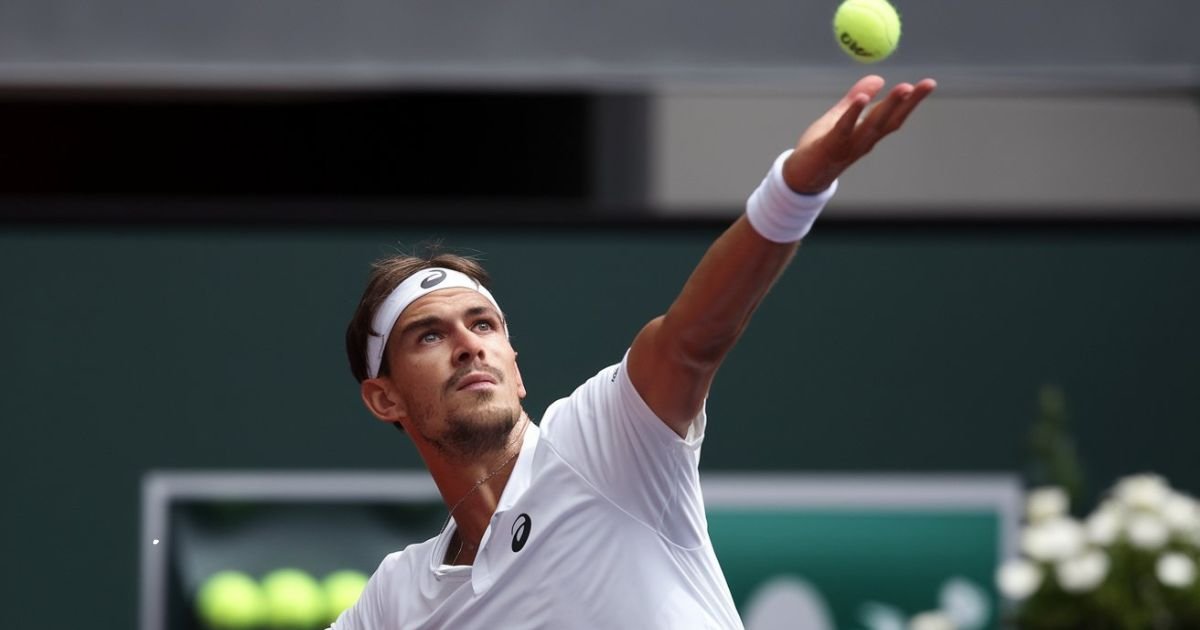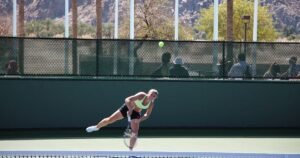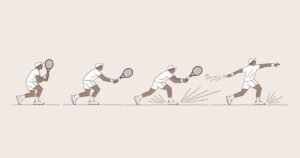The perfect tennis serve is your key to starting strong and making an impact from the very first point. Imagine stepping onto the court, confident in your serve as a powerful weapon that sets the tone for the match.
A flawless serve isn’t just about clearing the net; it’s about dominating the game right from the start. With a perfect tennis serve, you put your opponent on the defensive and control the pace.
In this article, we’ll reveal expert tips to help you master the perfect tennis serve, from refining your stance and grip to enhancing your technique for powerful, accurate, and unpredictable serves.
Table of Contents
Mastering the Fundamentals
The Importance of a Solid Stance
A great serve begins with a solid stance. Picture this: you’re about to serve, your feet are positioned just right, shoulder-width apart, with your weight balanced perfectly. This stance is the cornerstone of your serve, much like the foundation of a house. Without it, everything else crumbles. By maintaining a balanced and stable stance, you give yourself the best chance to generate power and control.
Finding the Right Grip for Control and Power
The grip you choose can be as personal as your signature. Whether you lean towards the Continental or Eastern grip, what matters most is that it feels like an extension of your arm. It’s more than just technique; it’s about how connected you feel to your racket. The right grip allows you to deliver a serve with confidence, whether you’re going for a flat, powerful shot or a spin-laden trickster.
The Role of the Toss in Serve Success
The toss might seem like a minor detail, but it’s the linchpin of a successful serve. Think of it as setting up a perfect domino chain; one wrong move and everything falls apart. When you toss the ball, it’s as if you’re placing it gently on a shelf, right in your strike zone. A consistent, well-placed toss sets the stage for a smooth, controlled serve. Without it, even the best techniques can fall short.
The Kinetic Chain
Serving isn’t just an arm action; it’s a full-body movement, like a wave building up before crashing onto the shore. The kinetic chain starts from your feet, travels through your legs, hips, and torso, and finally, unleashes through your arm and racket. When each part of your body works in harmony, the result is a serve that’s both powerful and efficient. It’s the difference between a serve that feels forced and one that flows effortlessly.
Perfecting Serve Placement
Different Serve Types
There are Four types of Serve in Tennis.
- Flat Serve: This is your power move. It’s fast, direct, and hits like a bullet across the court. Use the flat serve to overpower your opponent, giving them barely a moment to react.
- Slice Serve: Think of a sly fox making a sharp getaway. The slice serve curves away from your opponent, making it tough for them to anticipate and reach. It adds variety and pulls them off the court, targeting the outer edges of the service box.
- Kick Serve: Here’s where the craftiness comes in. The kick serve bounces high, often above your opponent’s comfort zone, forcing them into awkward positions. It’s especially handy for second serves when you need consistency and precision.
- Topspin Serve: Picture a wave building up and crashing down with perfect timing. The topspin serve generates a forward spin, causing the ball to dip quickly after it crosses the net. It’s a reliable option that pushes your opponent back, giving you control over the baseline.
By mastering these serve types, you can keep your opponent guessing and maintain a strategic edge, painting the court with a variety of strokes.
Precision and Accuracy
When you serve, the service box becomes your canvas. Your job is to paint the corners, hit the lines, and make your opponent scramble. It’s not just about power; it’s about precision. A well-placed serve, whether it’s wide, down the T, or into the body, can create opportunities for easy points. By aiming for specific targets within the service box, you can exploit your opponent’s weaknesses and control the flow of the game.
Analyzing Opponent Positioning to Determine Serve Strategy
Serving is as much about your opponent as it is about you. Take a moment to observe where they stand, how they move, and what they seem to expect. Are they crowding the baseline, ready to pounce? Or are they hanging back, giving you space? By reading their positioning, you can tailor your serve to catch them off guard. It’s a game of chess one where the right serve can checkmate your opponent.
How to Mix Up Your Serves to Keep Opponents Guessing
No one likes predictability, especially in tennis. If your opponent knows what’s coming, they’re halfway to winning the point. That’s why it’s essential to mix up your serves. Throw in a flat serve one moment, then surprise them with a topspin the next. Keep them guessing, and they’ll be less likely to anticipate your next move, giving you the upper hand.
Mental Preparation
Visualization in Serving Success
Your mind is a powerful tool, capable of shaping your game as much as any physical skill. Before you serve, take a moment to visualize the perfect shot. See the ball arcing through the air, landing exactly where you want it. This mental rehearsal can boost your confidence and sharpen your focus, making the actual serve feel like something you’ve already mastered.
Techniques to Stay Calm and Focused
Serving under pressure can feel like standing on a tightrope. One misstep, and you’re off balance. But here’s a secret: even the pros feel the nerves. The key is to embrace the pressure and turn it into focus. Whether it’s a deep breath, a quick bounce of the ball, or a calming thought, find your anchor. In those high-pressure moments, it’s not just about what you do it’s about how you stay composed.
Develop a Pre-Serve Routine for Consistency
Consistency is the backbone of a great serve, and a pre-serve routine is your best friend. Think of it as a ritual a series of small, deliberate actions that center you. Whether it’s adjusting your grip, bouncing the ball, or taking a deep breath, a routine helps you find your rhythm. It’s a way to quiet the mind and prepare the body, ensuring that each serve starts from the same place, even if the outcome changes.
Common Serve Mistakes and How to Correct Them
Identifying and Fixing Toss Errors
One of the most common serve mistakes is a faulty toss. It’s frustrating when the ball doesn’t land where you need it, throwing off your entire serve. But like anything in tennis, it’s fixable. Practice tossing the ball to the same spot over and over again. Make it muscle memory, so when you’re in the heat of the match, your toss is the one thing you don’t have to worry about.
Overcoming Nerves and Inconsistencies in Motion
Nerves can be a tennis player’s worst enemy, leading to inconsistent motions and erratic serves. The key to overcoming them lies in your mindset. Instead of letting nerves control you, use them to your advantage. Focus on your breathing, slow down your motion, and remind yourself that you’ve practiced this serve a thousand times. Confidence, even if it’s a bit forced at first, can carry you through those shaky moments.
How to Avoid Double Faults and Other Common Pitfalls
Double faults are the nightmare of every server. They not only give away points but also sap your confidence. To avoid them, focus on control over power, especially on your second serve. A safer, well-placed serve is better than a risky one that might miss. And remember, even the best players have off days. The goal is to minimize mistakes and keep your head in the game.
Drills and Exercises to Perfect Your Serve
Solo Drills for Improving Toss, Spin, and Placement
You don’t always need a partner to improve your serve. Solo drills can be incredibly effective. Work on your toss by practicing against a wall, aiming for consistency. To improve spin, experiment with your wrist snap and follow-through, feeling how the ball reacts to different touches. For placement, set up targets and aim for them, refining your accuracy with each repetition. It’s about building confidence and making every aspect of your serve second nature.
Partner Drills for Simulating Match Conditions
While solo drills are great, nothing beats the real thing. Partner drills can simulate the pressure and unpredictability of a match. One effective drill is to alternate serves and returns, forcing you to adapt quickly. Another is to have your partner mix up their returns, challenging you to adjust your serve on the fly. These drills not only improve your technique but also sharpen your mental game, preparing you for whatever comes your way.
Strength and Flexibility Exercises to Enhance Serve Performance
A powerful serve requires more than just good technique; it also demands strength and flexibility. Strengthen your core with exercises like planks and medicine ball twists, and build leg power with squats and lunges. Flexibility, especially in your shoulders and hips, is crucial for a smooth, injury-free serve. Incorporating regular stretching into your routine can make a significant difference in your serve’s fluidity and power.
Insights from Tennis Pros
Tips from Professional Tennis Players
What do the pros do that the rest of us don’t? They approach serving with a level of detail and discipline that’s worth emulating. Many top players emphasize the importance of consistency, mental toughness, and continuous practice. They also share tips on how to stay calm under pressure and how to refine your technique, even after years on the court. Learning from the best can inspire you to elevate your own game.
How the Pros Approach Their Serve Training
Professional players don’t just practice serve they dissect them. They break down their motion, analyze their toss, and focus on even the smallest details. This meticulous approach helps them perfect their serves and maintain consistency, even in high-stakes matches. By adopting a similar mindset, you can take your serve from good to great.
How Pros Stay Confident Under Pressure
The mental game is where champions are made. Pros have mastered the art of staying focused and confident, even when the pressure is on. They use techniques like visualization, deep breathing, and positive self-talk to keep their minds sharp. By incorporating these strategies into your own routine, you can develop the mental resilience needed to serve with confidence, no matter the situation.
Conclusion
Mastering the perfect tennis serve is a journey, not a destination. It’s a process of continuous improvement, where every practice session brings you closer to your goal. By focusing on the fundamentals, refining your technique, and building mental toughness, you can develop a serve that’s not only effective but also a reflection of your unique style.
So keep practicing, stay patient, and remember the perfect serve is within your reach, waiting to be unleashed.





Pingback: How to Beat a Pusher in Tennis: 5 Proven Winning Tactics